If you want crispy, golden-brown skin with juicy, flavorful meat, cooking cast iron chicken thighs is the way to go! Using a cast iron skillet ensures even heat distribution, creating a perfect sear while locking in moisture. This technique is simple, reliable, and delivers restaurant-quality results at home. Ideal for a quick weeknight meal or a hearty, satisfying dinner, this method guarantees deliciously tender thighs with minimal effort!
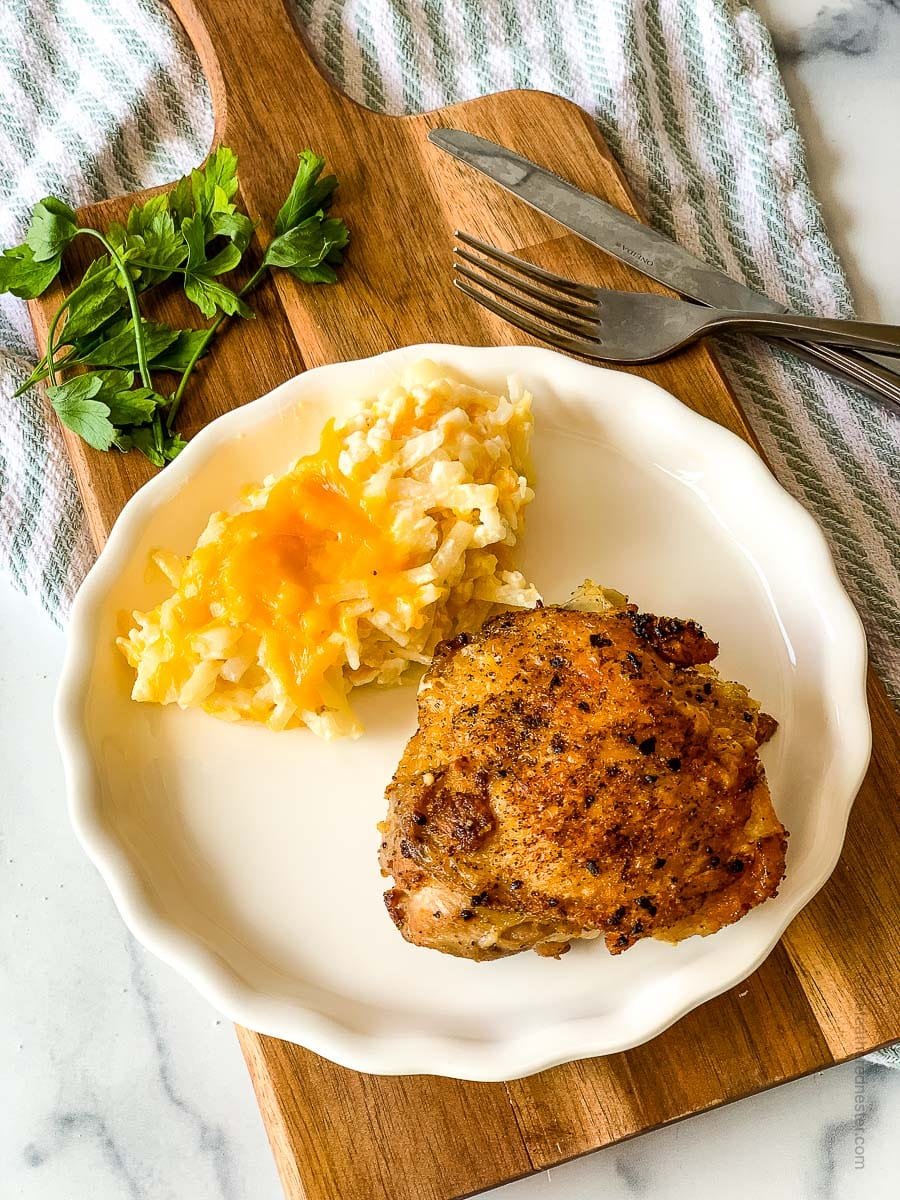
Using a cast iron skillet for thighs is a foolproof method for achieving crispy, flavorful results every time. The skillet’s even heat retention creates a golden, seared crust, while finishing them in the oven ensures perfectly cooked, juicy meat.
What makes this cast iron chicken thighs recipe even better is its incredible versatility. Keep it simple with butter, garlic, and fresh herbs, or elevate the flavor with your favorite spice blends. Plus, leftovers make meal prep a breeze—use them in salads, wraps, sandwiches, or quick weeknight meals for a delicious protein boost!
Why We Love this Cast Iron Chicken Thighs Recipe
- Quick under 30-minute meal.
Like our chicken caprese pasta, thighs are a great quick and easy dinner idea that are ready in minutes.
- Easy clean up.
Do you know that if it’s seasoned properly, cast iron cookware is actually more non-stick than Teflon?! When you want a delicious meal that you can cook quickly, pull out your cast iron skillet!
- Great for busy weeknights!
This recipe is perfect for a busy weeknight, or really any time you need a quick and easy meal idea. The thighs can even be cooked in advance and then reheated.
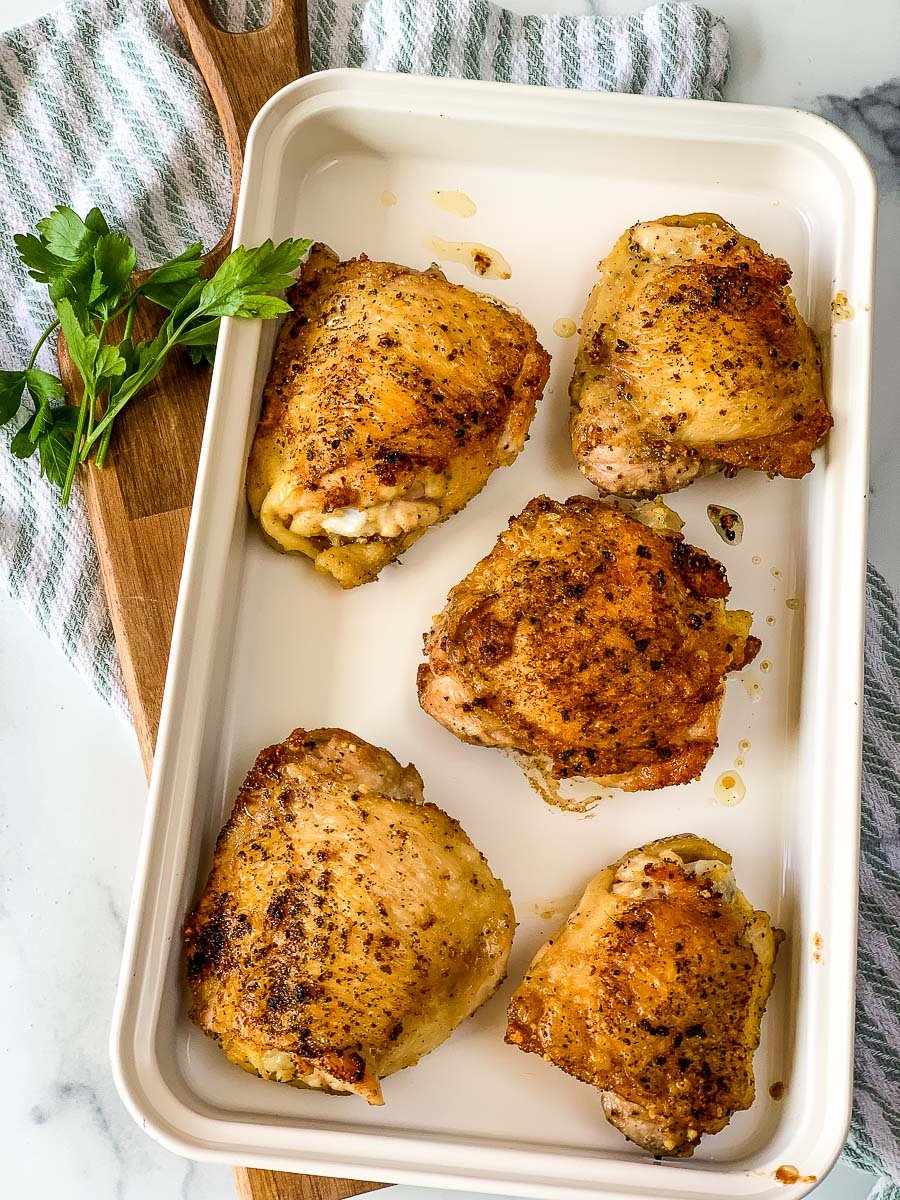
Love easy chicken recipes?
If one pan meals are your go-to, definitely check out our recipes for cast iron chicken breast and chicken thighs sheet pan dinner. For more options, learn how to cook marinated chicken tenders or make some spicy hot chicken tenders.
Ingredient Notes and Substitutions
- Chicken: We use bone-in skin-on thighs, and we leave the skin on. This keeps the meat extra juicy and tender. If you prefer boneless skinless thighs, you can use them, but you won’t be able to sear them as well.
Also, boneless meat doesn’t take as long to cook, so you will need to reduce the cooking time by about 5 minutes. - Seasonings: To keep things simple, we only season with garlic salt and black pepper for this recipe. However, you can use different spices, such as smoked paprika, garlic powder, onion powder, or a blend of herbs like rosemary and thyme.
Recipe Variations
- Add some heat with a pinch of cayenne pepper.
- Drizzle with sauce or gravy. Healthy, yogurt-based shawarma sauce is delicious with pan seared chicken!
- For a more flavorful dish, try marinating the meat with our chicken balsamic marinade.
- Classic crispy skin: For extra crispy skin, pat the thighs dry with a paper towel before seasoning. Cook them skin-side down in a cast iron pan with unsalted butter or avocado oil to get a perfect golden-brown crust.
- Italian-style: Season with Italian seasoning, garlic powder, and kosher salt for a flavorful Mediterranean twist. Serve with a side of roasted veggies or pasta.
- Herb butter infusion: Baste the thighs with a mixture of unsalted butter, garlic, and fresh herbs while cooking for extra flavor.
- Stove-top to oven method: While the stove-top gives a great sear, finishing the cast iron skillet chicken thighs in the oven ensures they stay juicy and tender inside.
With just a few ingredients and minimal effort, you can master the art of cast iron chicken thighs and enjoy a delicious, home-cooked meal in no time. Keep reading for step-by-step instructions, expert tips, and the best seasonings to enhance your dish!
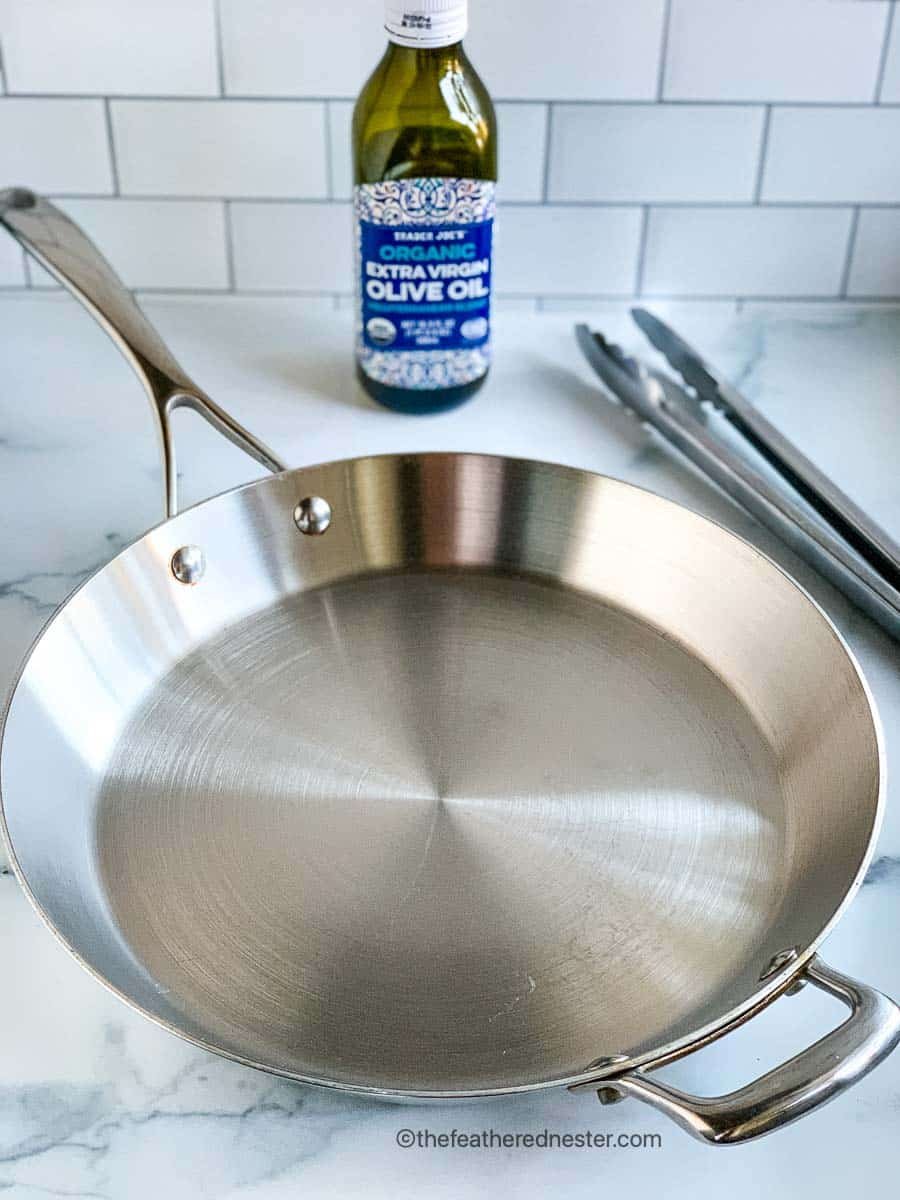
How to Make Cast Iron Skillet Chicken Thighs
- Avoid using a non-stick pan.
You want the skin to make contact with the pan and stick! That is the key to creating golden, crispy goodness.
If you don’t have a cast iron skillet, use any other type of heavy, oven-safe pan. The high heat you need for searing chicken can damage non-stick cookware.

- Preheat your skillet so it’s searing hot before adding oil.
The key to preventing thighs (or any other food) from sticking in a cast iron skillet is to ensure that the skillet and the oil are both hot before you add it to the pan.
Wait for the pan to get hot, add the oil, and wait until it begins to shimmer, then add the food.
🎯 TFN Pro Tip – Don’t crowd the pan
If your cast iron skillet is small, you may need to sear the thighs in two batches. If the pieces are too close together, they will steam rather than sear.
- Resist the urge to move the pan seared chicken as it cooks.
After adding the thighs to the pan, leave them alone until it’s time to flip the pieces over. As soon as the skin is properly seared, it will release itself from the skillet.

🎯 TFN Pro Tip – use a meat thermometer!
Wondering how long to cook thighs in cast iron skillet? If you use a meat thermometer, you’ll have perfectly cooked meat every time, eliminating the risk of tough, overcooked meat.
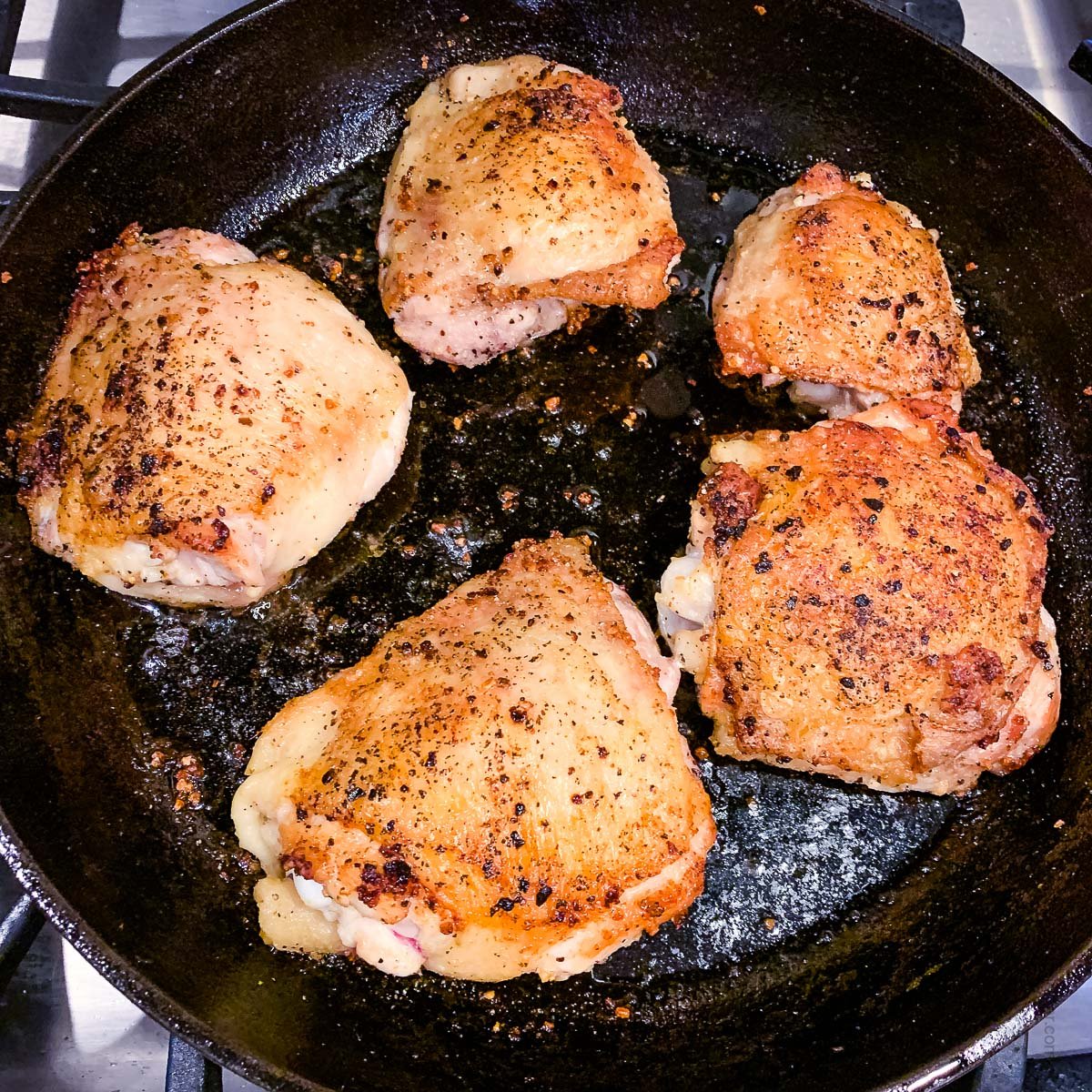
- Finish cooking your pan seared thighs in the oven.
Technically, cast iron thighs can be cooked from start to finish in the pan on your stovetop. However, it takes a lot longer to cook bone-in meat to 165°F when there’s no heat circulating around the pieces.
This is why we finish roasting them in the hot oven! It just needs 10 to 15 minutes to finish cooking through. - Use an instant-read kitchen thermometer to test cast iron skillet chicken thighs for doneness.
When properly cooked, cast iron thighs should have an internal temperature of 165°F, at the thickest portion of the meat. Be sure the probe of the thermometer isn’t touching any bone.
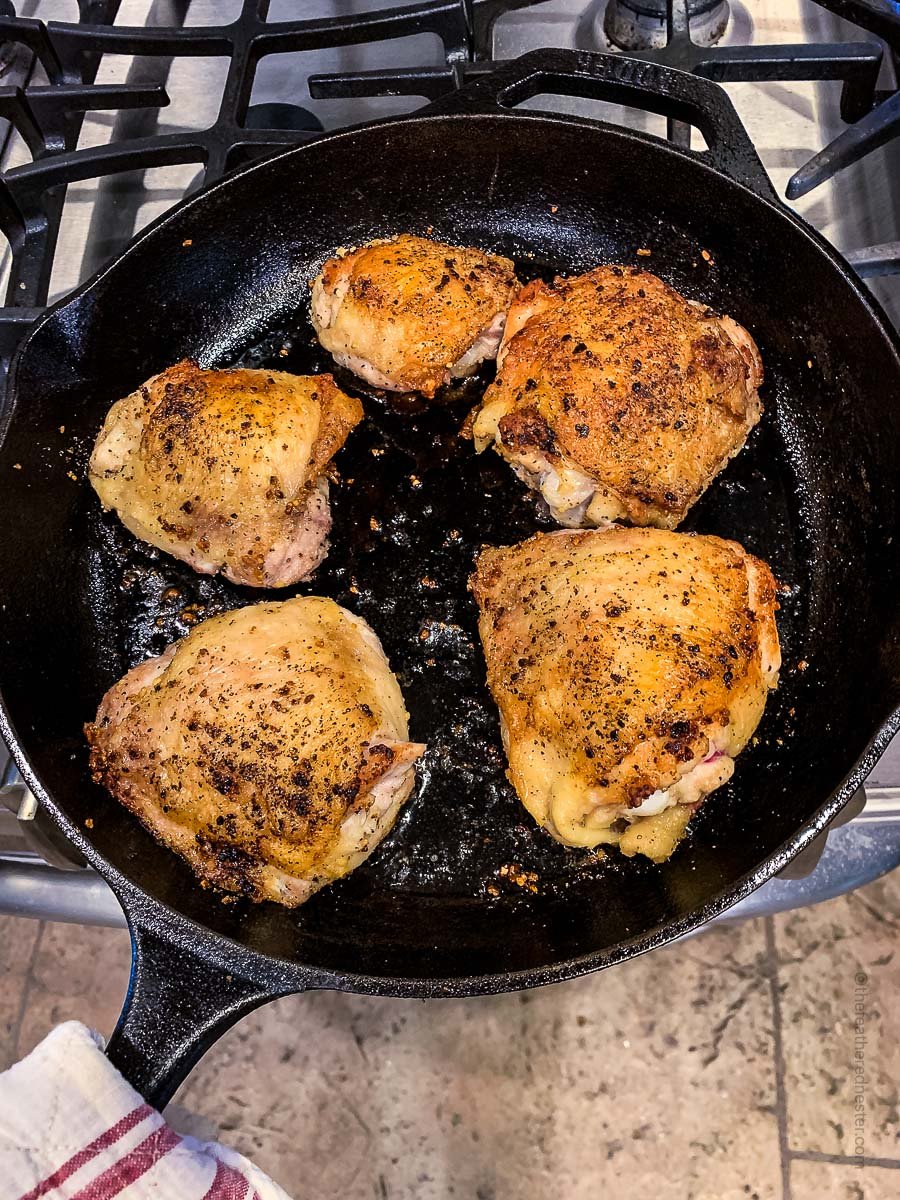
Serving Suggestions
Wondering what to serve with this recipe? How about some Instant Pot red potatoes mashed, or hashbrown casserole (as shown in our photos). For a bit of healthy greens, we recommend how to cook fresh green beans in Instant Pot, maple glazed brussel sprouts, or a tahini dressing kale salad recipe.
This cast iron chicken thighs recipe also pairs perfectly with roasted sweet potatoes or sauteed asparagus for a delicious balance of flavor and texture. Looking for a complete meal? Add a side of green beans, mix vegetables, or a fresh garden salad.
If you’re serving this meal for a gathering, complement it with a warm loaf of crusty bread and a glass of white wine or sparkling water. And if you have leftover thighs, shred them up for tacos, grain bowls, sliders, or sandwiches the next day!
Recipe FAQs
It’s likely overcooked. Cooking thighs or breasts in a cast iron skillet can be tricky because the skillet retains so much heat. For the best results, use a digital instead-read cooking thermometer, cooking the meat until the internal temperature is 163 degrees F. As it rests after cooking, the internal temperature will rise to 165 degrees F.
Leftover chicken thighs can be stored in an airtight container in the fridge for up to four days. Reheat in the microwave or oven until warmed through before serving.
You could also freeze the cooked thighs for up to three months. Thaw in the fridge overnight and then reheat before serving.
To reheat, cook in a 350ºF oven until warmed through. You can also reheat them in the microwave, but cover the dish with a damp paper towel to prevent the meat from drying out.
If you are reheating frozen baked meat, thaw it in the fridge overnight before reheating.
Yes! Boneless thighs cook faster and are still delicious, but bone-in thighs provide more depth of flavor and juiciness.

More Easy Dinner Recipes To Love…
- Smoked Tenderloin Pork
- Pineapple Chicken Bowls with Fried Rice
- BBQ Chicken Tenders Baked
If you tried this chicken thigh recipe or any other recipe on my website, please leave a 🌟 star rating and let me know how it went in the 📝 comments below. Thanks for visiting!
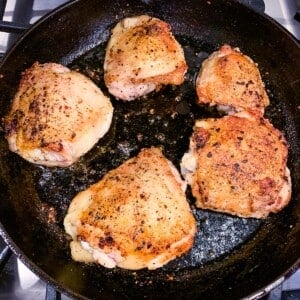
Cast Iron Chicken Thighs
Equipment
- large cast iron skillet - 11-12 inches
- small bowl
- tongs
- instant-read thermometer
Ingredients
- 2 pounds chicken thighs bone-in, skin on (about 6 thighs)
- 2 teaspoons garlic salt
- ½ teaspoon black pepper
- 2 tablespoons olive oil
Instructions
- Heat oven to 425ºF.
- Dry the chicken thighs by patting dry with paper towel.
- In a small bowl, combine the garlic salt and pepper. Sprinkle on both sides of chicken.
- Add 1 to 2 tablespoons of olive oil on cast iron skillet and preheat over medium-high heat until hot, oil should be shimmering but not smoking.
- Place chicken thighs into the pan, skin side down. Do not cover with a lid, instead use a splatter screen to contain the oil. Cook without moving them at all for 5-7 minutes to give the chicken skin the perfect crispy sear.
- Once the chicken skins are deep golden and crispy, use long tongs to turn flip the chicken pieces over and do the same to the other side.
- Transfer the skillet with the chicken to the oven and roast for 10-15 minutes until cooked through. Test the internal temperature of the center of the chicken thighs (avoiding the bone) with an instant read meat thermometer and if it is 165ºF they are done.

Harriet Young says
These were really good – juicy and tender! Served them with a couscous salad and it was delicious.
Mahy says
Can’t wait to try this recipe over the weekend – seems awesome, and the result is great!
Donalyn says
This might be my new favorite way to make chicken – it’s such a great method!